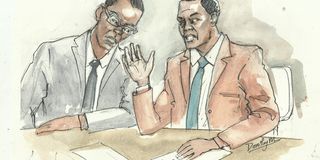Doctor blames death on anaesthetic error

What you need to know:
The doctor who was also the proprietor of the hospital invited a surgeon from Nairobi to carry out the operation. The surgeon was, however, not registered with the Uganda Medical and Dental Practitioners Council
A doctor and an anaesthetist were acquitted by the Chief Magistrate of Buganda Road Court on June 12, 2014.
The two had been prosecuted for causing the death by a rash or negligent act when a patient under their care died during a surgical operation on October 14, 2010.
The doctor who was also the proprietor of the hospital invited a surgeon from Nairobi to carry out the operation. The surgeon was, however, not registered with the Uganda Medical and Dental Practitioners Council.
Ingredients of the offence
Court determined that the offence had two ingredients that prosecution had to prove beyond reasonable doubt and these were;
1. That the two accused acting together, did a rash and negligent act.
2. The act in (1) above caused the death of the patient.
The rash and negligent act, as described in the charge sheet, was “failing to ensure that the tube which was supposed to supply oxygen and anesthesia to the lungs of the patient was properly inserted into her trachea before embarking on the surgery”.
Common intent
Court relied on the evidence of two defense witnesses to conclude that the doctor was not in theatre at the time of operation. To court the prosecution therefore failed to prove beyond reasonable doubt that the doctor was in the operating theatre, the scene of the alleged crime. To court common intention could, therefore, not stand without the participation of at least two persons at the onset of the alleged offence.
The rash and negligent act
The next logical question court posed was whether in absence of common intention, there was evidence pointing to the individual participation of each of the accused persons in the rash and negligent act complained of in the charge sheet. The doctor’s lawyer submitted that the rash and negligent act complained of was not specifically described under the law.
The law defines “rash” as doing something that may not be sensible without first thinking of the possible results. Synonyms of this are “impulsive” and “reckless”. The law also defines “Negligent” as ‘failing to give enough care or attention, especially when this has serious results.
Court looked at the evidence before it. One of this was the witness statement of the surgeon to the Medical and Dental Practitioners Council. The surgeon told the Council that death of the patient was as a result of wrong intubation. The pathologist concurred with the surgeon and stated that the death was “consistent with intra-operative neurogenic cardiac arrest and associated acute gastritis”. A member of the Medical Council told court that the death was in fact an anesthetic accident. An expert witness told court that the hospital did not appropriate anesthetic equipment for laparoscopic surgery.
The anesthetist, in his defense, told court that he had successfully administered anaesthesia in over 700 procedures at the hospital and in his entire career he had successfully administered anaesthesia in tens of thousands of cases. He told court that this was the first case ever in which he was accused of wrongdoing and indeed if he had erred then the patient would not have been alive for the 20 minutes she was on the operating table before the alarms went off.
Surgeon blamed
It was the court’s finding that at the time the surgeon gave his statement from Nairobi to the Medical Council incriminating the anaesthetist, he (the surgeon) was the lead suspect in this case.
He was for all intents and purposes a potential co-accused in this matter and court was of the opinion that he was aware of this. What to court was not clear was whether the Medical Council, which received and relied on the surgeon’s statement to draw conclusions, was aware of this conflict of interest. To court the surgeon could not therefore be an independent witness, given the fact that in his statement he totally absolved himself of any wrongdoing in the matter and put all the blame on the anaesthetist.
Court further noted that the surgeon did not physically give evidence in court unlike other witnesses and this is also what happened before the Medical Council. To court the evidence of the surgeon that the Council relied on could not be treated as part of the court records and therefore, as far as court was concerned, the surgeon’s opinion in this matter was hearsay evidence and inadmissible in court.
Cause of death
The evidence from the Medical Council was to the effect that proprietor of the hospital told the Council that he thought the cause of death in this case was an anaesthetic accident and that in his opinion the anesthetist was responsible. However while giving his evidence in court the doctor did not repeat this opinion.
When asked by his advocate what he thought was the cause of death he was elusive and replied, “The cause of death was established” and did not offer any further explanation. He did not tell court who established the cause of death. To court, therefore, the reasons why the doctor did reiterate his opinion on the cause of death remained unclear and this left the court with no professional opinion from the doctor as to what he thought of the cause of death. Court in this matter then had to examine the post-mortem report.
To be continued




